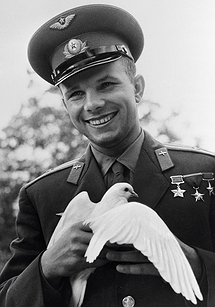به ازای هر نفری که با دعوت شما در منظوم ثبتنام میکنند 20 امتیاز میگیرید.
لینک دعوت:


The perpetually smiling Gagarin, who was promoted from senior lieutenant to major in the Soviet Air Force and was awarded the honor Hero of the Soviet Union for his accomplishment, became an international celebrity. He made many trips to foreign lands, including three to the United Kingdom, to publicize the Soviet space program that, since its inception with Sputnik in 1957, had been more advanced than that of the United States. Thus, Gagarin was a prime pawn in the propaganda wars between the two countries at the height of the Cold War.
He was appointed a deputy to the Supreme Soviet in 1962 before he went back to the Soviet cosmonaut training facility, Star City, where the extremely bright Gargarin worked designing reusable spacecraft. He eventually was promoted to the rank of full Colonel of the Soviet Air Force. His celebrity was still so great, the Soviet government refused to let him return to space, though he eventually was chosen as one of the astronauts for the Soviet moon landing program. Though he had been trained as jet fighter pilot, his superiors limited his flight time so as not to lose one of the USSR's greatest heroes of the Cold War period.
Gagarin was chosen as the backup pilot for the Soyuz 1 flight, the first flight of a program that was intended to put a Soviet cosmonaut on the moon by 1968. The flight was made by team leader Vladimir Komarov, and the launch of Soyuz 1 was opposed by Gagarin due to safety concerns. Gararin was right: the Soyyz I capsule crashed after re-entry on April 24, 1967, making Komarov the first person to die during a space flight. After the incident, Gagarin again was banned from participating in the manned space program as an active cosmonaut. He was appointed deputy training director of Star City.
The 34-year-old Gagarin died on March 27, 1968 during a routine training flight in a MiG-15UTI. The ashes of Gagarin and co-pilot Vladimir Seryogin were entombed in the Kremlin and Star City was renamed in his honor.
Soviet space program architect Sergei Korolev claimed that Gagarin had a smile "that lit up the Cold War". But for the crash of Soyuz 1 (which signaled the ultimate failure of the Soviet moonshot program), Gagarin, the first man in space, might have been the first on the moon. He was honored by American astronauts Neil Armstrong and Buzz Aldrin, the first men on the moon, when they left behind a bag containing medals commemorating Gagarin and Komarov on the lunar surface.